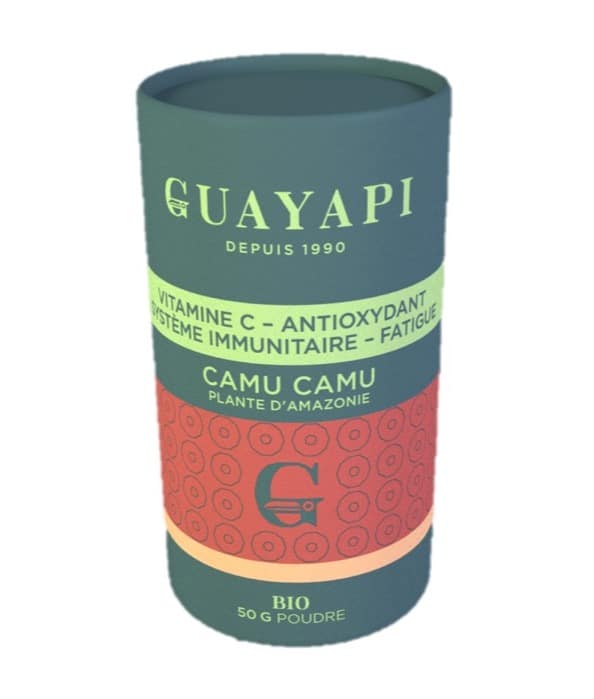BENEFITS OF CAMU CAMU
✓ High vitamin C content
✓ Powerful antioxidant
✓ Anti-inflammatory
✓ Natural antimicrobial
✓ May help with weight loss
What is camu camu?
The camu camu (Myrciaria dubia) is the fruit of a tree of the same name, native to the Amazon rainforest, and belonging to the Myrtaceae family – like guava. Sometimes partially submerged, it grows along the riverbanks in the Peruvian and Brazilian Amazon, where it is sometimes cultivated using canoes.
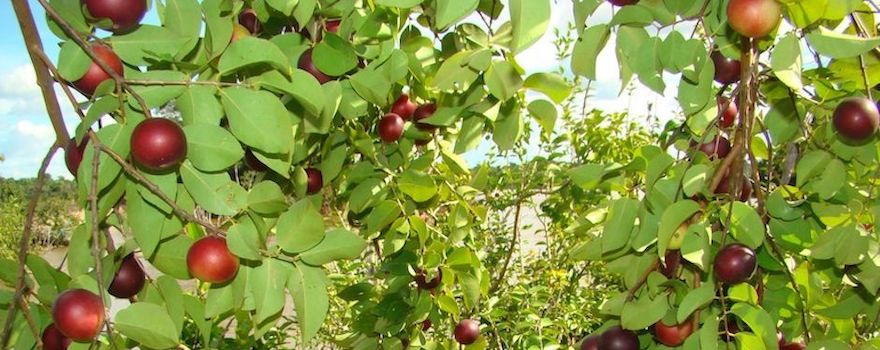
Its tree grows mainly in the wild, but larger-scale cultivation is developing as its popularity grows. It is a small very tart fruit in shades of pink, red, and yellow, particularly favored by Amazonian populations since pre-Columbian times.
Its highly pigmented skin gives it a candy-pink color when consumed as juice or in sorbet, and its seeds are removed to avoid any bitterness. It is customary to add sugar to any camu camu preparation to soften its taste.
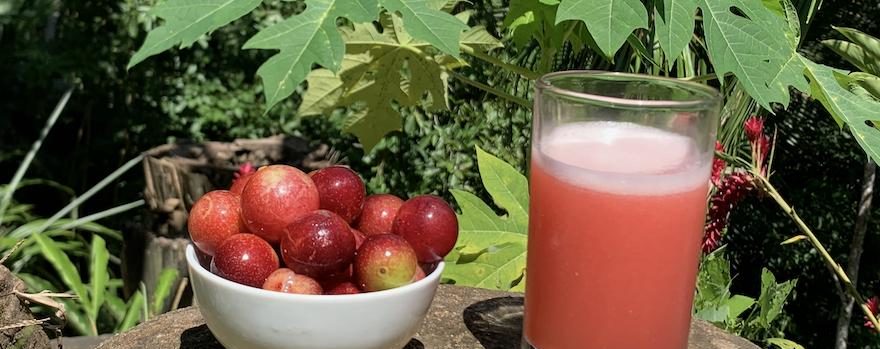
Beyond its taste and appearance, camu camu is becoming increasingly popular here because it is one of the fruits richest in vitamin C.
Indeed, this fruit contains 16 times more vitamin C than the orange and the lemon, and 20 times more than the kiwi!
It’s a particularly nutritious fruit. Besides vitamin C, its richness in antioxidants – flavonoids and other minerals means it is often found in dietary supplements in powder form.
The benefits of camu camu and its nutritional density have gradually become the focus of scientific research. Today studies are still limited, but they are beginning to expand given the nutritional qualities and health benefits already recognized.
Nutritional composition
- Protéines
- Fibres
- Vitamines : C, D
- Minéraux et oligo-éléments : sodium, calcium, potassium, fer
- Antioxydants : flavonoïdes, tanins, caroténoïdes
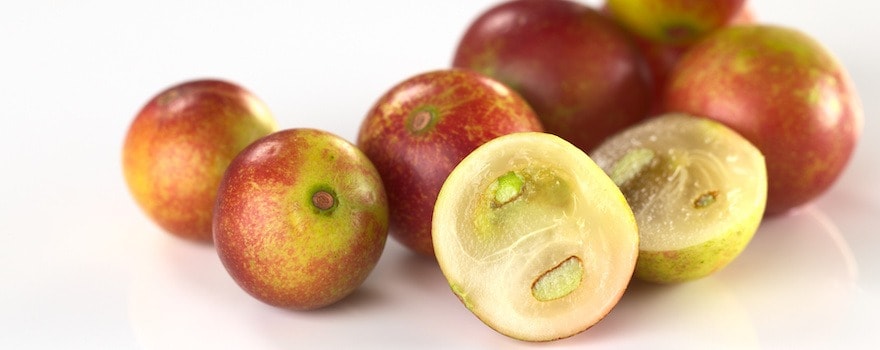
Buy organic camu camu: my selection
I recommend the organic camu camu from the French brand Guayapi. It is a premium product: it comes from wild harvesting, exclusively carried out by the Shipibo people in the Ucayali region of the Amazon.
I consistently recommend Guayapi to our readers because they source the best raw materials according to three fundamental criteria: organic, fair trade and biodiversity.
In fact, this brand is truly unique on the market: launched in 1990, Guayapi is a family business that embodies meaningful purpose and values. Feel free to visit their site to learn more about their approach.
When ordering, don’t forget to use our promo code “DARWIN10” which gives you 10% off camu-camu. This code is also valid on warana (another name for guarana) and açaí.
❤ I love : Exceptional quality, fair trade certification and Guyapi’s pioneering approach.
★ Customer reviews (Google): 4.6/5
☞ Quantity : 50 g
✔ 10% discount code: DARWIN10
The benefits of camu camu
🍊 High in vitamin C
Camu camu is an excellent source of vitamin C, containing between 3% and 9%. A teaspoon of powder contains 750% of the RDA (recommended daily allowance) of vitamin C.
Vitamin C is essential in several ways: it strengthens the immune system and acts as an antioxidant, protecting our cells from free radicals. It also allows our body to produce collagen, the protein that structures and strengthens our skin, muscles, bones…
It also helps absorb iron in our body.
This study from the State University of Maringá in Brazil demonstrated the high content and preservation capacity of the vitamin C found in camu camu.
🥝 Powerful antioxidant
In addition to vitamin C, which is a notable antioxidant, camu camu is particularly rich in other antioxidant substances, including flavonoids, tannins and carotenoids.
These help protect our cells and fight oxidative stress and free radicals.
This study, conducted in part by the Johns Hopkins University School of Medicine in Baltimore, demonstrated the strong antioxidant activity of camu camu.
🌵 Anti-inflammatory
Camu camu has anti-inflammatory properties, notably thanks to the ellagic acid it contains.
This polyphenol, present in many fruits and found in high amounts in camu camu, acts directly against inflammation.
This study from the Tokyo University of Marine Science and Technology, conducted on mice, demonstrated its anti-inflammatory properties.
🦠 Natural antimicrobial
Camu camu is a natural antimicrobial, helping to fight harmful bacteria and pathogens in our body, particularly in the digestive system.
This study from the Tokyo University of Agriculture, conducted in vitro, showed that the skin and seeds of camu camu reduce the growth of potentially pathogenic bacteria Escherichia coli and Streptococcus mutans.
🏃♂️ May help with weight loss
Camu camu is also reputed to contribute to weight loss. Its consumption is therefore recommended as part of weight-loss diets.
This fruit may help burn fat more easily and promote a healthy gut flora.
It may also help reduce blood sugar levels.
This study conducted by two Quebec universities on obese mice demonstrated camu camu’s ability to increase the number of calories burned and to benefit the gut flora.
Expert opinion on camu camu by Perrine Bellanger, our dietitian-nutritionist
Camu camu is a small fruit native to the Amazon. Rarely eaten on its own because of its acidity, it has nevertheless quickly gained popularity as a beverage, and of course as a superfood for its high vitamin C content.
💡Rich in vitamin C: The fresh fruit contains up to 3% of its weight in vitamin C! The recommended intake of vitamin C is about 100 mg per day for adults. In certain circumstances (stress, smoking, poor iron absorption, etc.), vitamin C supplementation is around 1 gram per day, which is on average one to two teaspoons of camu camu powder (about 15 grams).
Beyond this daily dose, there is a risk of overdose, the effects of which may include digestive issues and heartburn, as well as the formation of kidney stones.
💡Flavor: Its taste is distinctive, with both intense acidity and strong bitterness. Because of this particular flavor, it is recommended to incorporate camu camu powder into other preparations, such as juices and smoothies. Be careful with commercial juices, which are very sweet to mask the intensity of camu camu.
💡Supply: At present, camu camu is mostly harvested from the wild. However, due to the exponential increase in demand, the species could quickly become threatened. To address this situation, it is better to encourage organic, fair, and sustainable cultivation and production.
Perrine Bellanger – dietitian nutritionist
How to consume camu camu?
Choose organic camu camu
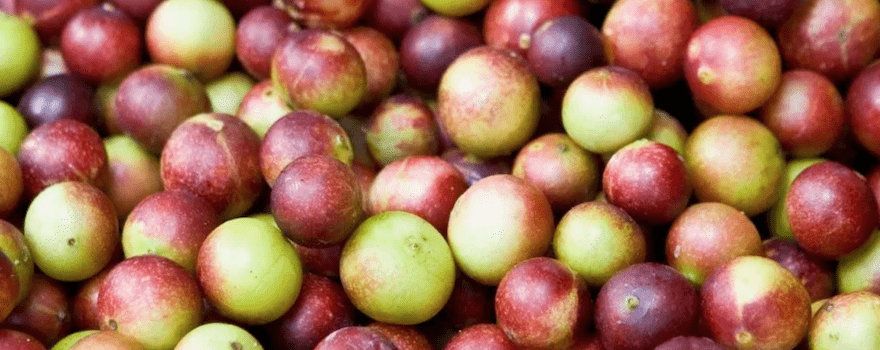
As with all the foods we recommend on Darwin Nutrition, we advise choosing organic camu camu. Fortunately, it is often wild-harvested or grown on a small scale, and cultivated without fertilizers or pesticides. Prefer a fruit whose origin is clearly indicated by the distributor, and which carries certification labels for organic farming, regardless of the form in which it is consumed: powder, juice, or fresh fruit (the latter are only available in the Amazon!).
Camu camu powder

Camu camu is available in powder form in European markets. You should always make sure the powder is made of 100% camu camu and contains no additives or preservatives. It is easily mixed into a smoothie, yogurt, or milkshake…
You can also mix it well with water, but watch out for its rather bitter taste when it isn’t accompanied by another fruit or a sweet ingredient.
Camu camu powder is sometimes mixed with other superfruit powders, such as acerola (the vitamin C content is then significantly increased) or maca, another superfood also native to Peru.
Camu camu juice

If you have the chance to travel to the Peruvian or Brazilian Amazon, you’ll inevitably be offered fresh camu camu juice to try! Served in restaurants, street canteens, and people’s homes, it’s part of what are called “refrescos”. A good shot of vitamin C! Be careful about added sugar, which can vary from place to place.
There are also commercial camu camu juices that are blends with other fruits (apple, for example). A local curiosity, but with very limited nutritional value!

Fresh camu camu
Actually, fresh camu camu is only consumed as juice with added sugar. Because it is very bitter, it is not customary to eat it directly as a fresh fruit. But if you have the chance to taste it, don’t hesitate!
Dosage
Unless you travel to the Amazon — which we hope you do — you’ll most likely consume camu camu in powder form.
⏳ Start with a 30-day course to see the effects, and continue beyond that if needed.
🥄 One to two teaspoons per day are enough – preferably in the morning to limit sleep disturbances.
Contraindications and side effects
When the recommended doses are followed, there are no contraindications or notable side effects from its consumption.
- Il n’y a pas de surdosage en vitamine C lorsqu’on consomme la pulpe et les graines séchées de camu camu, contrairement à la vitamine C de synthèse.
- Il est néanmoins déconseillé en cas de problèmes rénaux.
Detailed nutritional values of camu camu
These data were compiled and verified for Darwin Nutrition by Laure Fourchaud, PhD in nutritional physiology.
| Camu Camu | /100g | %RI* | 5g (1 tsp) | %RI |
| Energy (kcal) | 314 | 15.7 | 15.7 | 0.78 |
| Fiber (g) | 30 | 100 | 1.5 | 5 |
| Water (g) | — | — | — | — |
| Macronutrients | ||||
| Protein (g) | 2.8 | 5.6 | 0.14 | 0.28 |
| Carbohydrates (g) | 55.6 | 21.38 | 2.78 | 1.01 |
| Of which sugars (g) | 5.6 | 6.22 | 0.28 | 0.31 |
| Fat (g) | 2.5 | 3.57 | 0.12 | 0.19 |
| Minerals | ||||
| Calcium (mg) | 15.5 | 1.93 | 0.77 | 0,1 |
| Iron (mg) | 0,5 | 3.57 | 0.02 | 0.18 |
| Copper (mg) | 0,2 | 20 | 0.01 | 1 |
| Magnesium (mg) | 12 | 3.2 | 0,6 | 0.16 |
| Manganese (mg) | 2 | 100 | 0.1 | 5 |
| Phosphorus (mg) | — | — | — | — |
| Potassium (mg) | 83 | 4.15 | 4.15 | 0.21 |
| Sodium (mg) | 11 | 0.44 | 0.55 | 0.02 |
| Salt (g) | 0.65 | 10.83 | 0.03 | 0.54 |
| Zinc (mg) | 0.35 | 3.5 | 0.01 | 0.17 |
| Vitamins | ||||
| Vitamin A (mg) | — | — | — | — |
| Vitamin C (mg) | 6068 | 7585 | 303.4 | 379.25 |
| Vitamin E (mg) | — | — | — | — |
| Vitamin B1 (mg) | — | — | — | — |
| Vitamin B2 (mg) | — | — | — | — |
| Vitamin B3 (mg) | — | — | — | — |
| Vitamin B5 (mg) | — | — | — | — |
| Vitamin B6 (mg) | — | — | — | — |
| Vitamin B9 or folates (μg) | — | — | — | — |
| Vitamin K (µg) | — | — | — | — |
*%AR : % Reference intake for an adult
Other antioxidant compounds: phenolic compounds (flavonoids), carotenoids
Sources and scientific studies
Justi KC, Visentainer JV, Evelázio de Souza N, Matsushita M, 2000. Nutritional composition and vitamin C stability in stored camu-camu (Myrciaria dubia) pulp.
Paul C. Langley, Joseph V. Pergolizzi, Robert Taylor, Caroline Ridgway, 2015. Antioxidant and Associated Capacities of Camu Camu (Myrciaria dubia): A Systematic Review.
Yazawa K, Suga K, Honma A, Shirosaki M, Koyama T, 2011. Anti-inflammatory effects of seeds of the tropical fruit camu-camu (Myrciaria dubia).
Kaneshima T, Myoda T, Toeda K, Fujimori T, Nishizawa M, 2017. Antimicrobial constituents of peel and seeds of camu-camu (Myrciaria dubia).
Anhê FF, Nachbar RT, Varin TV, Trottier J, Dudonné S, Le Barz M, Feutry P, Pilon G, Barbier O, Desjardins Y, Roy D, Marette A, 2018.Treatment with camu camu (Myrciaria dubia) prevents obesity by altering the gut microbiota and increasing energy expenditure in diet-induced obese mice.



